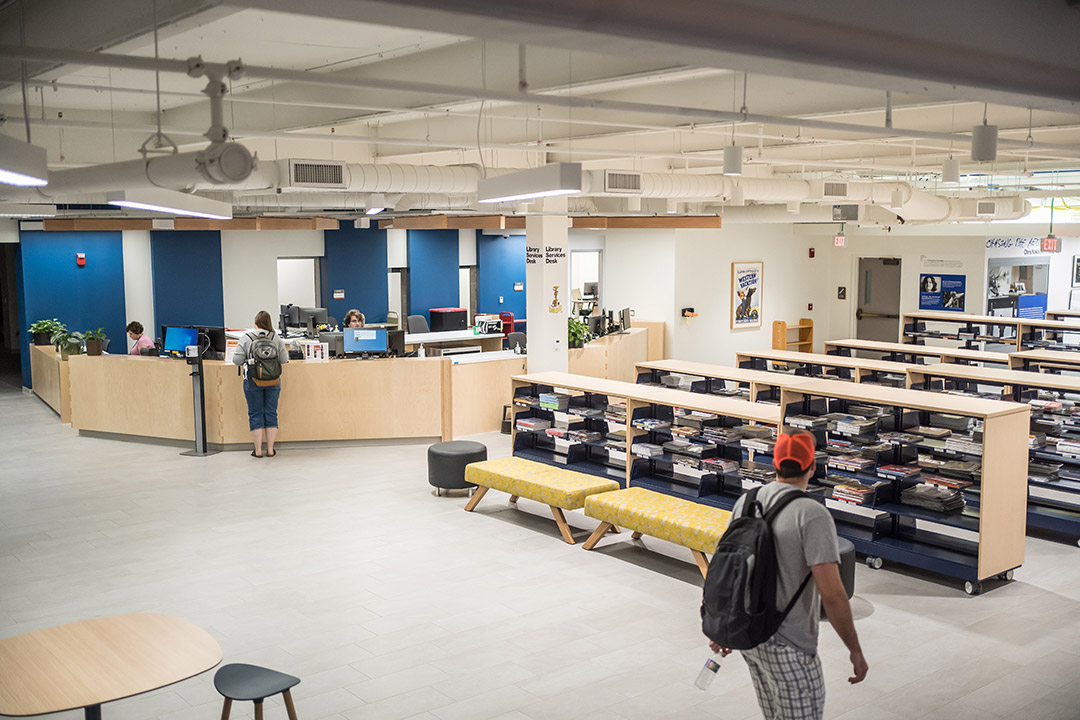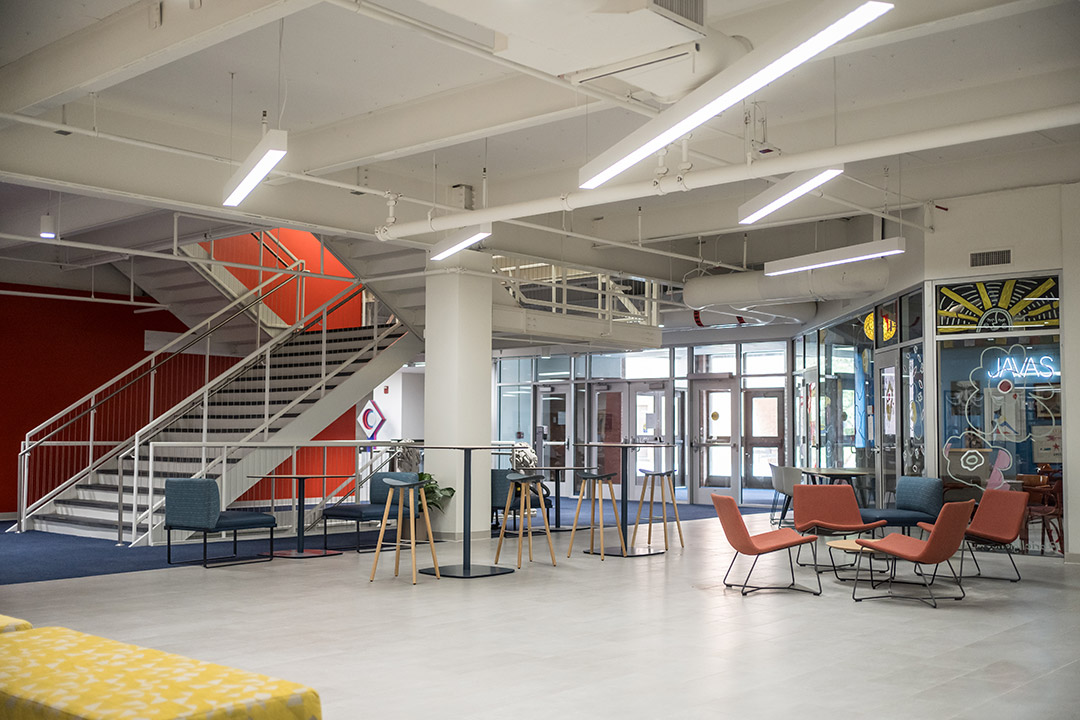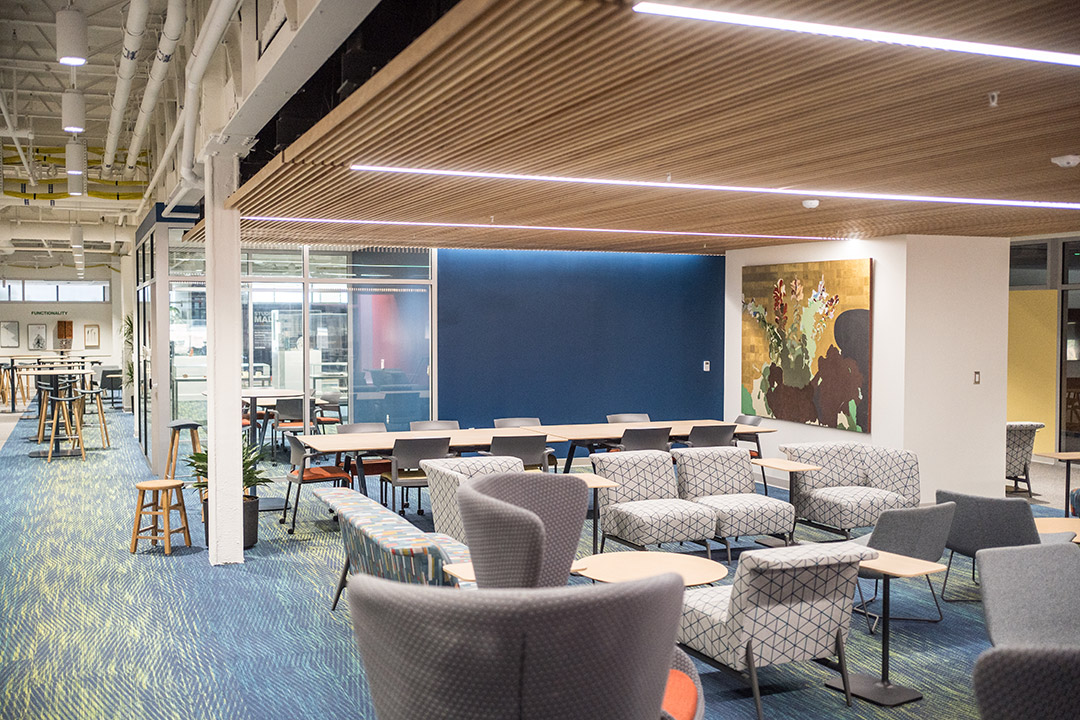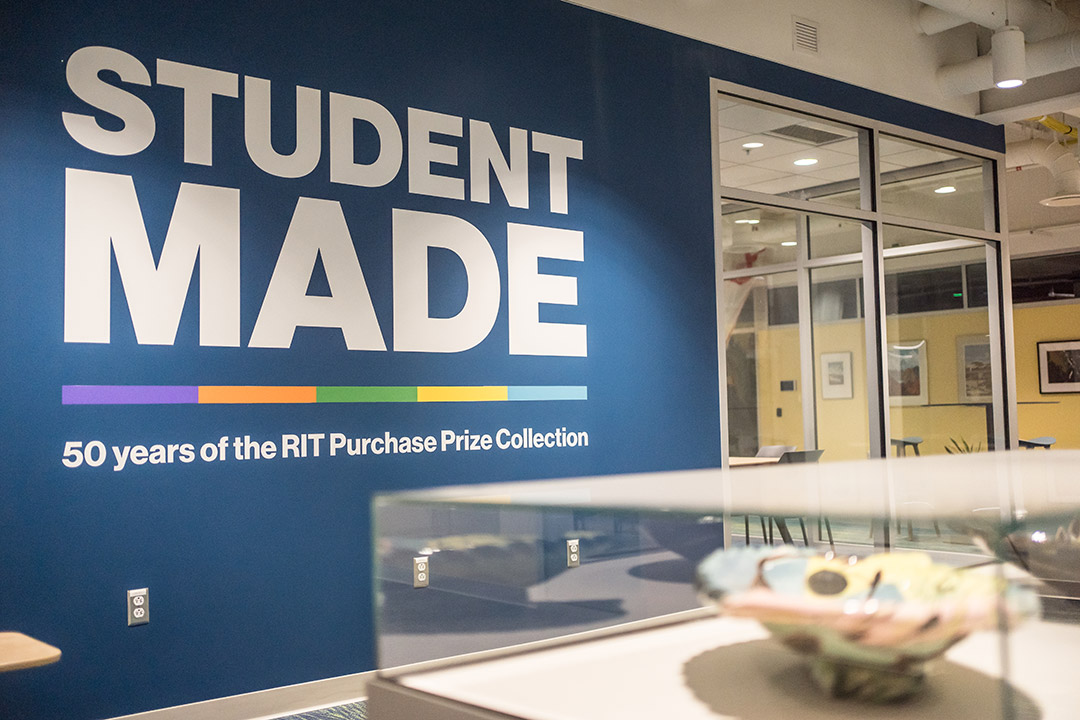Well, hello, Wallace Library, have we met?
New classrooms, study spaces, exhibits, and more make up renovated university library
Traci Westcott/RIT
RIT’s Wallace Library has a new look and a new Library Service Center.
First came COVID-19, then came a massive construction project, and now after more than three-and-half years, RIT’s university library reopens with a new look and a new neighbor.
Wallace Library adjoins the Student Hall for Exploration and Development (SHED)—the new maker space, performing arts, and classroom facility. The SHED design redefined the library, condensing its footprint while increasing its visibility to students and opportunities to engage with the campus community.
SHED Update
Classrooms in the SHED opened Aug. 28. Other parts require further work with a goal of completion around mid-semester. Read more about the SHED.
Wallace Library represents a new experience for everyone on campus, from first-year students to veteran faculty and staff. Many students in their second and third years know the library only as “Wallace on Ice,” when the circulation desk and materials moved to the Frank E. Ritter Arena to maintain services during construction.
Back in Wallace Library, the circulating materials and journals are shelved on the first and second floors. Many of the books and bound journals that were removed from the building are held in a separate location. Offsite storage is a growing trend in academic libraries for print materials that are useful but not heavily used, according to Marcia Trauernicht, director of RIT Libraries.
Traci Westcott/RIT
Open spaces and natural light fill the Wallace Library foyer. Café seating spills into the library.
A new remote storage specialist, Hannah Morrison, joined the library in the spring to manage these materials and the courier service that makes them accessible to patrons.
“A number of academic libraries have been converting space that was taken up by some of the print collections into seating and other functions that serve students and faculty,” Trauernicht said.
Repurposing space once filled with books also reflects a shift to electronic materials.
“Over 90 percent of our materials budgets are for electronic materials—e-books, e-journals, streaming media, and databases,” Trauernicht said.
Here’s a look at changes to Wallace Library:
Classrooms and study spaces
Traci Westcott/RIT
Wallace Library offers students a variety of new study spaces and lounges.
Wallace Library houses 22 flexible classrooms that are designed for active learning on a smaller scale than the larger classrooms in the SHED. The spacious rooms on the third and fourth floors of Wallace Library will seat between 36 to 60 students. Remote projection capabilities and moveable furniture will enhance small-group collaboration.
Bringing back a traditional element of a university library, new study spaces are available on the top floors of the Wallace building. These include a variety of single and group study rooms and lounges, and a computer lab on the third floor.
The space is decorated with art from the RIT Archives’ collection selected by fourth-year student Athena Lemon, who studies art conservation and archival studies.
The RIT Archives
Traci Westcott/RIT
The retrospective, Student Made: 50 Years of the RIT Purchase Prize Collection, celebrates five decades of MFA student work collected by Wallace Library.
The RIT Archives has new quarters on the third floor, and its research center is built with glass walls for everyone to see the archivists and students handling items from the collection.
Student-curated exhibits will fill display cases in the corridors, and the RIT Museum is prominently located near classrooms and study spaces. The inaugural exhibit, “Student Made: 50 years of the RIT Purchase Prize Collection,” is a retrospective celebrating Wallace Library’s collection of art purchased from MFA students.
Students from RIT Professor Lorrie Frear’s Experiential Design class worked closely with university archivist Liz Call to curate the exhibit that will run through the end of spring. An exhibit opening will be held Sept. 14.
Preservation of digital archives is a critical role of contemporary archives, and Wallace Library has added its first digital archivist, Julia Novakovic, to its team. Novakovic joined RIT from The Strong National Museum of Play to manage the university’s digital archives.
Integrating archives and special collections into the whole library experience is another trend that has changed during the last 20 years, Call said.
“That involves us being more outward facing and in front of the collection, and not just behind doors and in dusty dark, hidden spaces where people aren’t sure what goes on in there,” Call said.
The change is also in the interaction with the archives staff, she said.
“We are part of the package. We are here to partner, and sometimes it might not always involve collections at all but working directly with faculty and students.”
The Cary Graphic Arts Collection
The Cary Graphic Arts Collection will hold its grand opening on Nov. 9. The Cary Collection is no longer a contiguous space but several focused areas on the second floor.
The Cary Collection Research Center is an active learning space that replaces the narrow reading room for instruction. The space can seat 30 students and will have a large screen, document camera, and a magnetic wall for teaching with posters and framed art.
“We are trying to create even more energies around our collections than in the past, and to create a space that is hands-on and reaches students and new communities,” said Steven Galbraith, curator of the Cary Collection. “We have holdings that represent most fields of study at RIT. We can find artifacts in our collection that will interest any class.”
Galbraith anticipates many students will be interested in the new Kubert Comics Lounge and Gallery, featuring the late DC Comics legend Joe Kubert’s drafting table, and artwork by Kubert and his son, Marvel Comics artist Adam Kubert ’81 (medical illustration). The grand opening and first exhibition, “Spider-Man India,” will be held Sept. 21.
The redesign of the second floor includes a special place of honor for the Kelmscott/Goudy Press exhibit, a storied 19th-century press, and a semi-permanent exhibit of one of the most famous works it produced in 1896, the Kelmscott Chaucer.
The Cary Collection is a destination for visitors who come to RIT to see the press once owned by famed designers William Morris and Frederic W. Goudy, Galbraith said.
The “Milestones in Printing” exhibit lines the hallway leading from the SHED into the Cary Collection. Students will walk past examples of the evolution of type from the 1400s in Asia to 20th-century printing type designed by Goudy. Unforgettable large printing presses—all operational—line the hallway forming a timeline, from a reconstructed wooden press to early mid-20th-century machines.
A special section of the exhibit is dedicated to the former School of Printing, once a pre-eminent center for printing education. Advances in technology have changed the field and the discipline is now taught as print and graphic media technology within the College of Engineering Technology.
Ameila Hugill-Fontanel ’02 MS (printing technology, publishing), associate curator at the Cary Collection, is excited to teach in the Milestones in Printing exhibit, even with pedestrian traffic through the hallway. “I would love to have passersby drop into my class like a museum tour.”
“One of the things I have heard in all my time here is, ‘I had no idea this place existed,’” Hugill-Fontanel said. “Well, we are going to be featured very prominently now. I think that will be a point of pride. This is a very singular space in educational systems.”
The Cary Press Room is a letterpress makerspace in the SHED with working printing presses. The space will hold workshops and a pilot project with the letterpress credit-bearing class taught in the College of Art and Design, Hugill-Fontanel said.
The Cary Collection shares the second floor with The RIT Press—the university’s scholarly book publisher, which remains in its original location, and a new library instruction room.
Circulation desk
The new circulation desk, now called Library Services, is located where Wallace Library meets the SHED. Rebecca Budinger-Mulhearn has joined RIT from the Avon Free Library as the head of Library Services. Information Delivery Services remains in its original location and handles interlibrary loans.
The first floor walls double as exhibition space for the new RIT Archives Photo Alum Gallery, beginning to the right of the circulation desk and wrapping around the first-floor walls. The RIT Archives created the exhibit space with support from the College of Art and Design to recognize School of Photographic Arts and Sciences alumni work.
The inaugural exhibit for this space, “Chasing the Rectangle,” (Chris Nakis ’83), was curated by Emma Truscott, a fourth-year photographic and imaging arts major, who worked with the photographer. Truscott and Nakis will discuss their process at the opening reception on Sept. 27.
Familiar tenants in Wallace Library will also inhabit new space on the first floor, including the Writing Center, Expressive Communication Center, RIT ASL & Deaf Studies Community Center, Java’s (formerly Java Wally’s), and the Center for Teaching and Learning, located on the A-level.











